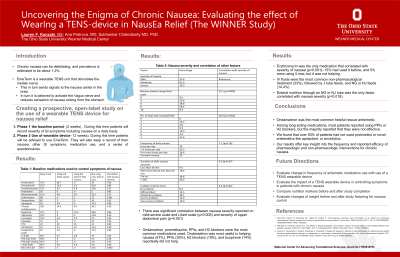Sunday Poster Session
Category: Functional Bowel Disease
P0542 - Evaluating the Efficacy of Pharmacologic and Non-Pharmacologic Interventions for Chronic Nausea
Sunday, October 22, 2023
3:30 PM - 7:00 PM PT
Location: Exhibit Hall

Has Audio

Lauren Kanzaki, MS
The Ohio State University
Columbus, OH
Presenting Author(s)
Lauren Kanzaki, MS1, Ana Petrova, MD2, Subhankar Chakraborty, MD, PhD1
1The Ohio State University, Columbus, OH; 2Ohio State University, New Albany, OH
Introduction: Chronic nausea can be debilitating. We sought to investigate the effectiveness of pharmacologic and non-pharmacologic agents in controlling chronic nausea.
Methods: Participants were recruited for an open-label study to investigate the effectiveness of a wearable TENS unit in controlling chronic nausea. To be eligible, they had to be 18 years or older, understand English and should have been suffering from nausea for 2 months or more. Exclusion criteria included current cancer treatment, IBD, cirrhosis, dialysis, implanted electronic devices, and history of arrhythmias. Nausea was classified as absent, "mild" (not requiring medications), "moderate" (requiring medications) and severe (uncontrolled with medications).
Results: 32 signed up and 10 were ineligible. 21 completed the nausea survey. Average age was 40 years (SD 11.07), and 81% were female. Most (75%) had moderate to severe nausea. On a 0-10 Likert scale, nearly 1 in 10 had 10/10 nausea. Most (47.6%) reported nausea 7 days a week. Nearly 1 in 5 reported constant nausea, and 3 out of 5 reported 2 or more episodes of nausea in a day. Nearly 40% also reported severe or very severe difficulty finishing a meal or feeling excessively full after a meal, and nearly half (47%) reported severe or very severe upper abdominal pain. There was significant correlation between nausea severity and severity of upper abdominal pain (p=0.051). Ondansetron, promethazine, PPIs, and H2 blockers were the most common medications used. More than 80% never tried granisetron, scopolamine, erythromycin, domperidone, or aprepitant. Ondansetron was most useful in helping nausea (67%). PPIs (35%), H2 blockers (19%), and buspirone (14%) did not help. Erythromycin was the only medication that correlated with severity of nausea (p=0.001)- 15% had used it before, and 5% were using it now, but it was not helping. 1 in 10 reported that IV fluids helped, and 1 in 20 that enteral feeding through a percutaneous jejunostomy tube reduced nausea. IV fluids were the most common non-pharmacological treatment (33%), followed by J tube feeds, and NG or NJ feeds (14.4%), with a small number reporting having tried feeding or venting through a PEG tube (4.8-9.5%). Enteral nutrition through an NG or NJ tube correlated with nausea severity (p=0.018).
Discussion: Although antisecretory drugs are commonly prescribed for nausea, they are not effective. Ondansetron was most common medication reported as being effective. Our study reveals gaps in management of chronic nausea.
Disclosures:
Lauren Kanzaki, MS1, Ana Petrova, MD2, Subhankar Chakraborty, MD, PhD1. P0542 - Evaluating the Efficacy of Pharmacologic and Non-Pharmacologic Interventions for Chronic Nausea, ACG 2023 Annual Scientific Meeting Abstracts. Vancouver, BC, Canada: American College of Gastroenterology.
1The Ohio State University, Columbus, OH; 2Ohio State University, New Albany, OH
Introduction: Chronic nausea can be debilitating. We sought to investigate the effectiveness of pharmacologic and non-pharmacologic agents in controlling chronic nausea.
Methods: Participants were recruited for an open-label study to investigate the effectiveness of a wearable TENS unit in controlling chronic nausea. To be eligible, they had to be 18 years or older, understand English and should have been suffering from nausea for 2 months or more. Exclusion criteria included current cancer treatment, IBD, cirrhosis, dialysis, implanted electronic devices, and history of arrhythmias. Nausea was classified as absent, "mild" (not requiring medications), "moderate" (requiring medications) and severe (uncontrolled with medications).
Results: 32 signed up and 10 were ineligible. 21 completed the nausea survey. Average age was 40 years (SD 11.07), and 81% were female. Most (75%) had moderate to severe nausea. On a 0-10 Likert scale, nearly 1 in 10 had 10/10 nausea. Most (47.6%) reported nausea 7 days a week. Nearly 1 in 5 reported constant nausea, and 3 out of 5 reported 2 or more episodes of nausea in a day. Nearly 40% also reported severe or very severe difficulty finishing a meal or feeling excessively full after a meal, and nearly half (47%) reported severe or very severe upper abdominal pain. There was significant correlation between nausea severity and severity of upper abdominal pain (p=0.051). Ondansetron, promethazine, PPIs, and H2 blockers were the most common medications used. More than 80% never tried granisetron, scopolamine, erythromycin, domperidone, or aprepitant. Ondansetron was most useful in helping nausea (67%). PPIs (35%), H2 blockers (19%), and buspirone (14%) did not help. Erythromycin was the only medication that correlated with severity of nausea (p=0.001)- 15% had used it before, and 5% were using it now, but it was not helping. 1 in 10 reported that IV fluids helped, and 1 in 20 that enteral feeding through a percutaneous jejunostomy tube reduced nausea. IV fluids were the most common non-pharmacological treatment (33%), followed by J tube feeds, and NG or NJ feeds (14.4%), with a small number reporting having tried feeding or venting through a PEG tube (4.8-9.5%). Enteral nutrition through an NG or NJ tube correlated with nausea severity (p=0.018).
Discussion: Although antisecretory drugs are commonly prescribed for nausea, they are not effective. Ondansetron was most common medication reported as being effective. Our study reveals gaps in management of chronic nausea.
Disclosures:
Lauren Kanzaki indicated no relevant financial relationships.
Ana Petrova indicated no relevant financial relationships.
Subhankar Chakraborty: Coloplast – Consultant. Medtronic – Consultant.
Lauren Kanzaki, MS1, Ana Petrova, MD2, Subhankar Chakraborty, MD, PhD1. P0542 - Evaluating the Efficacy of Pharmacologic and Non-Pharmacologic Interventions for Chronic Nausea, ACG 2023 Annual Scientific Meeting Abstracts. Vancouver, BC, Canada: American College of Gastroenterology.
